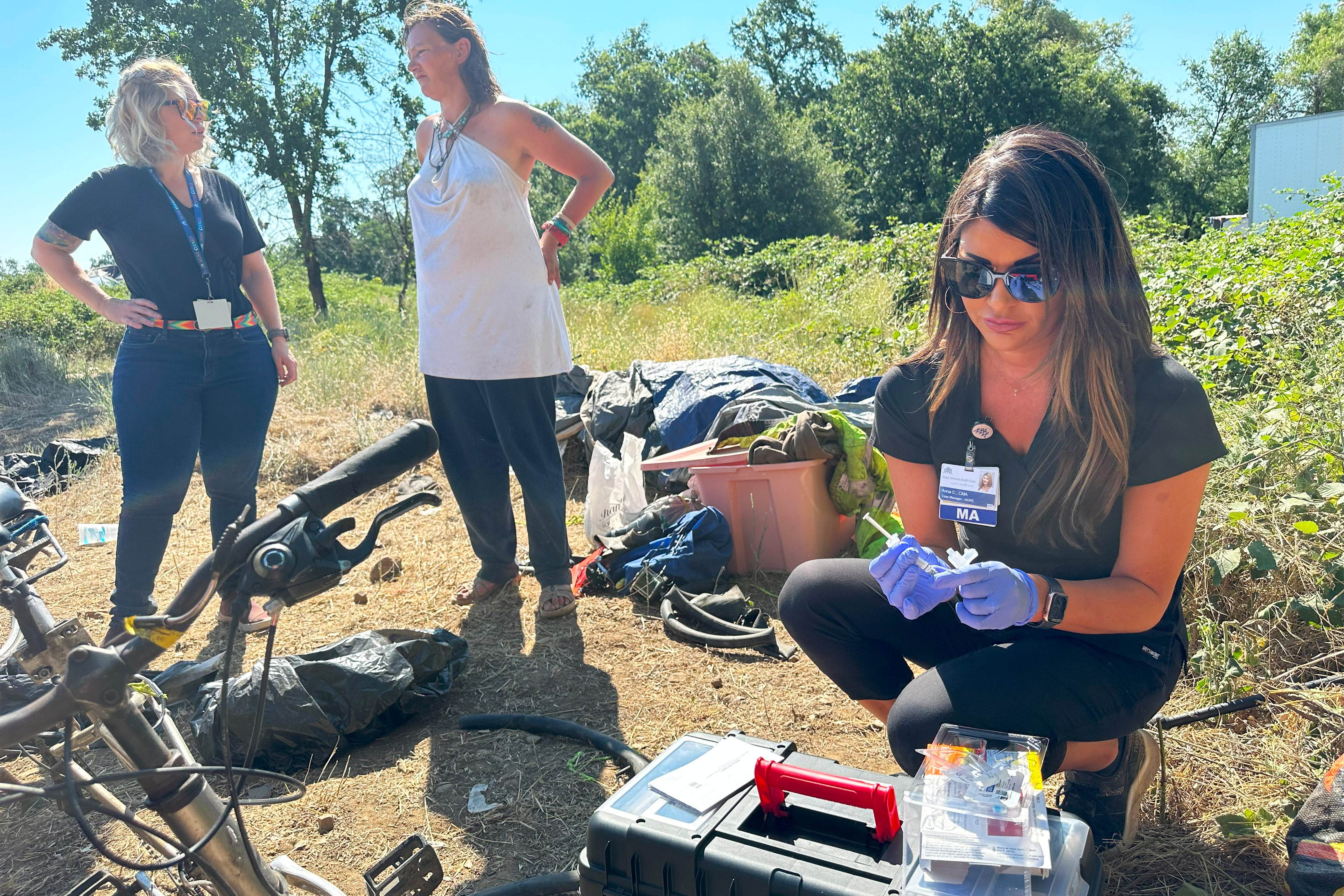This post was originally published on this site

The Biden administration is making it easier for doctors and nurses to treat homeless people wherever they find them, from creekside encampments to freeway underpasses, marking a fundamental shift in how — and where — health care is delivered.
Starting Oct. 1, the Centers for Medicare & Medicaid Services began allowing public and private insurers to pay “street medicine” providers for medical services they deliver anyplace homeless people might be staying.
Previously, these providers weren’t getting paid by most Medicaid programs, which serve low-income people, because the services weren’t delivered in traditional medical facilities, such as hospitals and clinics.
The change comes in response to the swelling number of homeless people across the country, and the skyrocketing number of people who need intensive addiction and mental health treatment — in addition to medical care for wounds, pregnancy, and chronic diseases like diabetes.
“It’s a game-changer. Before, this was really all done on a volunteer basis,” said Valerie Arkoosh, secretary of Pennsylvania’s Department of Human Services, which spearheaded a similar state-based billing change in July. “We are so excited. Instead of a doctor’s office, routine medical treatments and preventive care can now be done wherever unhoused people are.”
California led the nation when its state Medicaid director in late 2021 approved a new statewide billing mechanism for treating homeless people in the field, whether outdoors or indoors in a shelter or hotel. “Street medicine providers are our trusted partners on the ground, so their services should be paid for,” Jacey Cooper told California Healthline.
Hawaii and Pennsylvania followed. And while street medicine teams already operate in cities like Boston and Fort Worth, Texas, the new government reimbursement rule will allow more health care providers and states to provide the services.
“It’s a bombshell,” said Dave Lettrich, executive director of the Pittsburgh-based nonprofit Bridge to the Mountains, which provides outreach services to street medicine teams in Pennsylvania. “Before, you could provide extensive primary care and even some specialty care under a bridge, but you couldn’t bill for it.”
Under the new rule, doctors, nurses, and other providers can get reimbursed to care for patients in a “non-permanent location on the street or found environment,” making it the first time the federal government has recognized the streets as a legitimate place to provide health care. This will primarily affect low-income, disabled, and older people on Medicaid and Medicare.
“The Biden-Harris Administration has been focused on expanding access to health care across the country,” said CMS spokesperson Sara Lonardo, explaining that federal officials created a new reimbursement code at the request of street medicine providers who weren’t consistently getting reimbursed.
The White House unveiled an ambitious strategy earlier this year to reduce homelessness in America 25% by 2025, in part by plowing health care money into better care for those living on the streets.
Legislation pending in Congress would further expand reimbursement for street medicine, taking aim at the mental health and addiction crisis on the streets. The bipartisan bill, introduced earlier this year, has not yet had a committee hearing.
Nearly 600,000 people are homeless in America, based on federal estimates from 2022, and on average they die younger than those who have stable housing. The life expectancy for homeless people is 48, compared with the overall life expectancy of 76 years in the U.S.
More than 150 street medicine programs operate across the country, according to street medicine experts. At least 50 are in California, up from 25 in 2022, said Brett Feldman, director of street medicine at the University of Southern California’s Keck School of Medicine.
Feldman spearheaded the state and national efforts to help street medicine providers get paid, alongside the Street Medicine Institute. They submitted a formal request to the Biden administration in January 2022 to ask for a new street medicine billing code.
In the letter, they argued that street medicine saves lives — and money.
“This is done via walking rounds with backpacks, usually working out of a pick-up truck or car, but is also done via horseback, kayak, or any other means to reach hard-to-reach people,” they wrote. “The balance of power is shifted to the patient, with them as the lead of their medical team.”
Street medicine experts argue that by dramatically expanding primary and specialty care on the streets, they can interrupt the cycle of homelessness and reduce costly ambulance rides, hospitalizations, and repeated trips to the emergency room. Street medicine could help California save 300,000 ER trips annually, Feldman projected, based on Medicaid data. Some street medicine teams are even placing people into permanent housing.
Arkoosh said there’s already interest bubbling up across Pennsylvania to expand street medicine because of the federal change. In Hawaii, teams are plotting to go into remote encampments, some in rainforests, to expand primary and behavioral health care.
“We’re seeing a lot of substance abuse and mental health issues and a lot of chronic diseases like HIV,” said Heather Lusk, executive director of the Hawai‘i Health & Harm Reduction Center, which provides street medicine services. “We’re hoping this can help people transition from the streets into permanent housing.”
But the federal change, undertaken quietly by the Biden administration, needs a major public messaging campaign to get other states on board and to entice more providers to participate, said Jim Withers, a longtime street medicine provider in Pittsburgh who founded the Street Medicine Institute.
“This is just the beginning, and it’s a wake-up call because so many people are left out of health care,” he said.